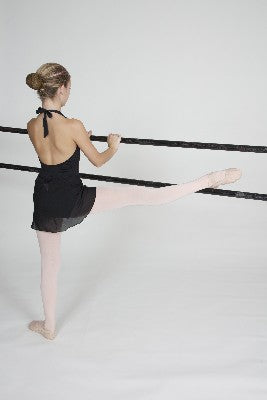A ballet barre workout is an excellent way to strengthen the body and improve flexibility, especially for those who are prone to foot issues like plantar fasciitis. The low-impact nature of barre exercises helps to build strength without putting undue stress on the joints, making it a great choice for anyone looking to enhance their fitness while protecting their feet. In this blog, we’ll explore a ballet barre workout plan designed to target the muscles in the feet, calves, and legs, helping to prevent plantar fasciitis. Incorporating specific barre exercises into your routine can strengthen the foot’s arch, reduce tension, and prevent injury.
The Importance of a Ballet Barre Workout for Foot Health
Ballet barre exercises are specifically designed to improve balance, flexibility, and strength. The moves incorporate various muscle groups, including those in the legs, core, and feet. By focusing on controlled movements and engaging different parts of the body, a ballet barre workout helps enhance overall foot health. A ballet workout can increase blood flow to the muscles in the feet, strengthening the arches and alleviating strain on the plantar fascia, which can help prevent conditions like plantar fasciitis. Consistent practice can also improve your posture and body alignment, providing long-term benefits to your feet and overall well-being.
Incorporating ballet barre exercises into your routine helps to gradually build up strength in the foot muscles, which supports the heel and reduces the likelihood of strain or injury. The controlled and intentional movements in ballet barre also allow you to work on flexibility, which is crucial for maintaining the foot’s health. With regular practice, you can create a more resilient foot structure that is less prone to injury and discomfort.
Exercises for Plantar Fasciitis Prevention
For those looking to prevent plantar fasciitis, certain exercises can target the muscles that support the foot and improve flexibility, reducing strain on the plantar fascia. Many ballet barre exercises are particularly effective at strengthening the feet and calves, two areas that play a vital role in preventing plantar fasciitis.
Relevé (Rise Up): The relevé is a fundamental barre exercise where you rise up onto your toes, engaging the calves, arches, and feet. By holding the position at the top for several seconds, you strengthen the muscles of the feet and improve ankle flexibility. This exercise helps strengthen the plantar fascia and reduces tension on the heel.
Plié with Foot Stretch: A plié is a common barre move that helps to target the calves and thighs, but when combined with a foot stretch, it can be particularly effective for plantar fasciitis prevention. As you bend your knees into a plié, focus on stretching your toes and arches, keeping your feet flat on the ground. This will help improve flexibility in the calves and prevent stiffness in the foot.
Tendu: The tendu is a barre exercise where you extend one leg in front, to the side, or behind you while keeping your toes pointed. This movement activates the muscles in the foot and strengthens the arches, which helps to alleviate tension in the plantar fascia. Practicing tendus regularly will improve the strength and flexibility of the feet, which is essential for preventing plantar fasciitis.
These exercises, when performed consistently, not only help to prevent plantar fasciitis but also improve the overall health and flexibility of your feet. In addition to strengthening the arches, they promote proper alignment and balance, which further reduces the risk of injury. A focused ballet barre workout plan with these exercises can create a more stable and flexible foot structure.
Fitness Barre: The Low-Impact Solution for Strengthening Feet
Fitness barre is a great alternative to high-impact workouts that can strain the feet and joints. Barre workouts are based on the principles of ballet, focusing on slow, controlled movements that allow for deep muscle engagement. Unlike running or jumping, which can put significant stress on the feet and exacerbate conditions like plantar fasciitis, fitness barre emphasizes low-impact exercises that provide the same benefits without the risk of injury.
Fitness barre exercises, such as pliés, relevés, and tendus, help to target the small muscles in the feet and calves, building strength in a safe and controlled manner. By engaging these smaller muscle groups, barre workouts improve stability, flexibility, and balance, which are all essential for preventing plantar fasciitis. Fitness barre also promotes better posture and alignment, which can reduce the strain on the feet and legs, preventing overuse injuries like plantar fasciitis.
In addition to strengthening the feet, fitness barre improves overall muscle tone, particularly in the core, legs, and arms. This well-rounded approach to fitness helps to create a balanced and strong body that supports the feet and reduces the risk of injury. For anyone dealing with foot issues or looking to prevent plantar fasciitis, fitness barre offers a comprehensive and low-impact workout solution.
How to Incorporate a Ballet Barre into Your Routine
To effectively prevent plantar fasciitis and improve foot health, consistency is key. You don’t need to spend hours at the barre—just 20 to 30 minutes a few times a week can make a significant difference. Start by incorporating simple exercises like relevés, pliés, and tendus into your workout routine, focusing on proper form and control.
If you’re new to barre workouts, consider starting with a beginner class or following along with online tutorials to ensure you’re performing the exercises correctly. Pay attention to your posture and alignment to avoid unnecessary strain on your feet and ankles. Over time, you can increase the intensity and variety of your workouts, adding more advanced exercises as your strength and flexibility improve.
In addition to barre workouts, it’s important to complement your routine with other foot care practices, such as stretching before and after exercise, wearing supportive footwear, and taking breaks if you’re on your feet for extended periods. Combined, these practices will help keep your feet healthy and reduce the risk of developing plantar fasciitis.
Ballet Barre for Foot Health
A ballet barre workout plan is an excellent way to prevent plantar fasciitis and improve overall foot health. By incorporating exercises that target the feet, calves, and legs, you can strengthen the muscles that support the plantar fascia and reduce the risk of injury. Using a fitness barre to workout is a low-impact, effective solution for anyone looking to protect their feet while improving their fitness. Whether you’re new to barre or a seasoned practitioner, incorporating these exercises into your routine can help you maintain strong, flexible, and injury-free feet. Keep your body balanced and your feet strong with a consistent ballet barre workout plan. For more information about how a ballet barre workout plan can help prevent plantar fasciitis, contact us today.





